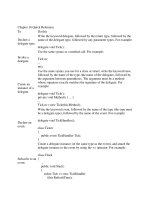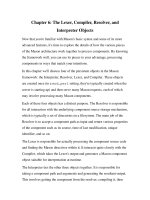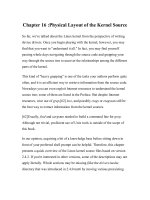Chapter 16 Wireless WANs: Cellular Telephone and Satellite Networks pot
Bạn đang xem bản rút gọn của tài liệu. Xem và tải ngay bản đầy đủ của tài liệu tại đây (1.14 MB, 37 trang )
16.1
Chapter 16
Wireless WANs:
Cellular Telephone
and Satellite Networks
Copyright © The McGraw-Hill Companies, Inc. Permission required for reproduction or display.
16.2
16-1 CELLULAR TELEPHONY
16-1 CELLULAR TELEPHONY
Cellular telephony
Cellular telephony
is designed to provide
is designed to provide
communications between two moving units, called
communications between two moving units, called
mobile stations (MSs), or between one mobile unit and
mobile stations (MSs), or between one mobile unit and
one stationary unit, often called a land unit.
one stationary unit, often called a land unit.
Frequency-Reuse Principle
Transmitting
Receiving
Roaming
First Generation
Second Generation
Third Generation
Topics discussed in this section:
Topics discussed in this section:
16.3
Figure 16.1 Cellular system
16.4
Figure 16.2 Frequency reuse patterns
16.5
AMPS is an analog cellular phone
system using FDMA.
Note
16.6
Figure 16.3 Cellular bands for AMPS
16.7
Figure 16.4 AMPS reverse communication band
16.8
Figure 16.5 Second-generation cellular phone systems
16.9
Figure 16.6 D-AMPS
16.10
D-AMPS, or IS-136, is a digital cellular
phone system using TDMA and FDMA.
Note
16.11
Figure 16.7 GSM bands
16.12
Figure 16.8 GSM
16.13
Figure 16.9 Multiframe components
16.14
GSM is a digital cellular phone system
using TDMA and FDMA.
Note
16.15
Figure 16.10 IS-95 forward transmission
16.16
Figure 16.11 IS-95 reverse transmission
16.17
IS-95 is a digital cellular phone system
using CDMA/DSSS and FDMA.
Note
16.18
The main goal of third-generation
cellular telephony is to provide
universal personal communication.
Note
16.19
Figure 16.12 IMT-2000 radio interfaces
16.20
16-2 SATELLITE NETWORKS
16-2 SATELLITE NETWORKS
A satellite network is a combination of nodes, some of
A satellite network is a combination of nodes, some of
which are satellites, that provides communication from
which are satellites, that provides communication from
one point on the Earth to another. A node in the
one point on the Earth to another. A node in the
network can be a satellite, an Earth station, or an end-
network can be a satellite, an Earth station, or an end-
user terminal or telephone.
user terminal or telephone.
Orbits
Footprint
Three Categories of Satellites
GEO Satellites
MEO Satellites
LEO Satellites
Topics discussed in this section:
Topics discussed in this section:
16.21
Figure 16.13 Satellite orbits
16.22
What is the period of the Moon, according to Kepler’s
law?
Example 16.1
Here C is a constant approximately equal to 1/100. The
period is in seconds and the distance in kilometers.
16.23
Example 16.1 (continued)
Solution
The Moon is located approximately 384,000 km above the
Earth. The radius of the Earth is 6378 km. Applying the
formula, we get.
16.24
According to Kepler’s law, what is the period of a satellite
that is located at an orbit approximately 35,786 km above
the Earth?
Example 16.2
Solution
Applying the formula, we get
16.25
This means that a satellite located at 35,786 km has a
period of 24 h, which is the same as the rotation period of
the Earth. A satellite like this is said to be stationary to
the Earth. The orbit, as we will see, is called a
geosynchronous orbit.
Example 16.2 (continued)









